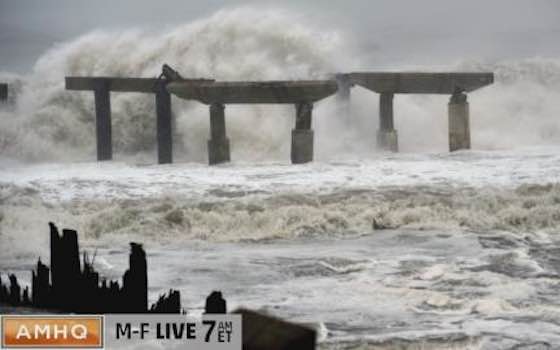- MENU
- HOME
- SEARCH
- WORLD
- MAIN
- AFRICA
- ASIA
- BALKANS
- EUROPE
- LATIN AMERICA
- MIDDLE EAST
- United Kingdom
- United States
- Argentina
- Australia
- Austria
- Benelux
- Brazil
- Canada
- China
- France
- Germany
- Greece
- Hungary
- India
- Indonesia
- Ireland
- Israel
- Italy
- Japan
- Korea
- Mexico
- New Zealand
- Pakistan
- Philippines
- Poland
- Russia
- South Africa
- Spain
- Taiwan
- Turkey
- USA
- BUSINESS
- WEALTH
- STOCKS
- TECH
- HEALTH
- LIFESTYLE
- ENTERTAINMENT
- SPORTS
- RSS
- iHaveNet.com: Environment

The New York City Panel on Climate Change found that New York City is expected to see more frequent heat waves and higher sea level rise.
New York City is vulnerable to sea level rise due to its coastal location. Here are some key points regarding sea level rise in New York City:
Rising Sea Levels
Sea levels have been rising globally due to climate change, primarily driven by the melting of glaciers and ice caps and the expansion of seawater as it warms. This rise is caused by the increased concentration of greenhouse gases in the atmosphere.
Vulnerability of New York City
New York City is particularly susceptible to sea level rise due to its low-lying geography and extensive coastal areas. The city's infrastructure, including buildings, transportation systems, and underground infrastructure, is at risk of flooding and damage.
Historical Sea Level Rise
Over the past century, sea levels in the New York City area have risen by around 1 foot (30 centimeters). This increase has been attributed to a combination of global sea level rise and local land subsidence.
Projections for the Future
Future projections vary depending on the rate of greenhouse gas emissions and the effectiveness of climate change mitigation efforts. However, estimates suggest that sea levels could rise by 1 to 4 feet (30 to 120 centimeters) by 2100, with potential for even higher levels in worst-case scenarios.
Impacts on Infrastructure
Sea level rise poses significant challenges for New York City's infrastructure, including its subway system, airports, and coastal defenses. Storm surges and high tides can result in more frequent and severe flooding, disrupting transportation and increasing the risk of damage to buildings and critical infrastructure.
Adaptation Measures
New York City has been implementing various adaptation measures to address sea level rise. These include the construction of protective infrastructure, such as seawalls and storm surge barriers, as well as efforts to elevate buildings and improve waterfront resilience.
Long-Term Planning
The city's long-term planning initiatives, such as the Climate Resiliency Design Guidelines and the OneNYC 2050 plan, aim to integrate climate resilience into urban planning and development, considering the impacts of sea level rise and other climate-related risks.
More Environment & Climate Change ...
- 5 Radical Takeaways from the Pope's Letter on Climate
- A Green-Energy Founding Father
- We're All Taking Dirty Pictures
- Faking It While the World Burns
- This Oil Spill Hits Close to Home
- A Fossil-Fueled Fantasy
- The Pentagon Makes War on Alaska's Pristine Wilderness
- Climate Denial Syndrome Sweeps Wisconsin
- How Climate Change and Resource Scarcity Are Upending World Politics
- Virginia Is for Dirty-Energy Lovers
- Humanity's War on Wildlife
- Making Green Cool Again in Hungary
- David and Goliath in the Amazon
- NASA Warns of 'Megadroughts'
- Our Growing Carbon Emissions
- Global Warming Triggered Syria War
- Round-the-World Solar Flight Takes Off
- 10 Extreme Weather Facts
- New York City Sea Level Rises
- Alaskan Glaciers Disappearing
- Leather Sludge New Bio-Fuel Source
- Why the Ocean is Turning More Acidic
- Why Whales Beach Themselves
- Termites Fight Climate Change
- Gas-Guzzlers On Road To Extinction
- Technology & Transformation
- Ecuador: All You Need Is Love and Oil?
- China Pulls Critical Pollution Documentary Offline
- Forging Our Future
- Green Believers
- The Glaciers Are Talking to Us
- Bald Eagles Nesting In New York City For First Time In 100 Years
- Asian Pollution Messing With U.S. Weather
- Instagram Account Shows Reality of Climate Change
- Keystone Pipeline Would Emit Tons of Greenhouse Gases
- Why You Can't Throw Away Batteries
- Road Salt Is Worse Than You Think
- Arctic Not Cold Enough for Polar Bears
- Doomsday Clock & Climate Change
- Sea-Level Accelerating Faster Than Previously Thought
- 6 Countries Dictate Planet's Future
- Manhattan Size Glacier Breaks Apart
- Opinions Split on Fracking Benefits
- Bad News for Sea Level Rise
- 2014 Hottest Year On Record According To NASA
- While Our Planet Melts, GOP Pleads Ignorance
- The Myth of the Wild
- Plastic Bags are Not a Need - Just a Bad Habit
- Environmental Security: Conflict or Cooperation?
- Beyond The Water-Food-Energy-Climate Nexus
- Climate Change Report Sounds Alarm for Planet Earth
- Genesis, Mother Nature and Environmental Stewardship
- Global Climate Change: Calling All Pagans
- Chicken Little 'Science'
- Climate Change and Interstate Conflict
- Fracking: A Deadly Power Surge
- Inhospitable Earth -- Compared to What?
More Environment & Climate Change ...
"New York City Sea Level Rises "